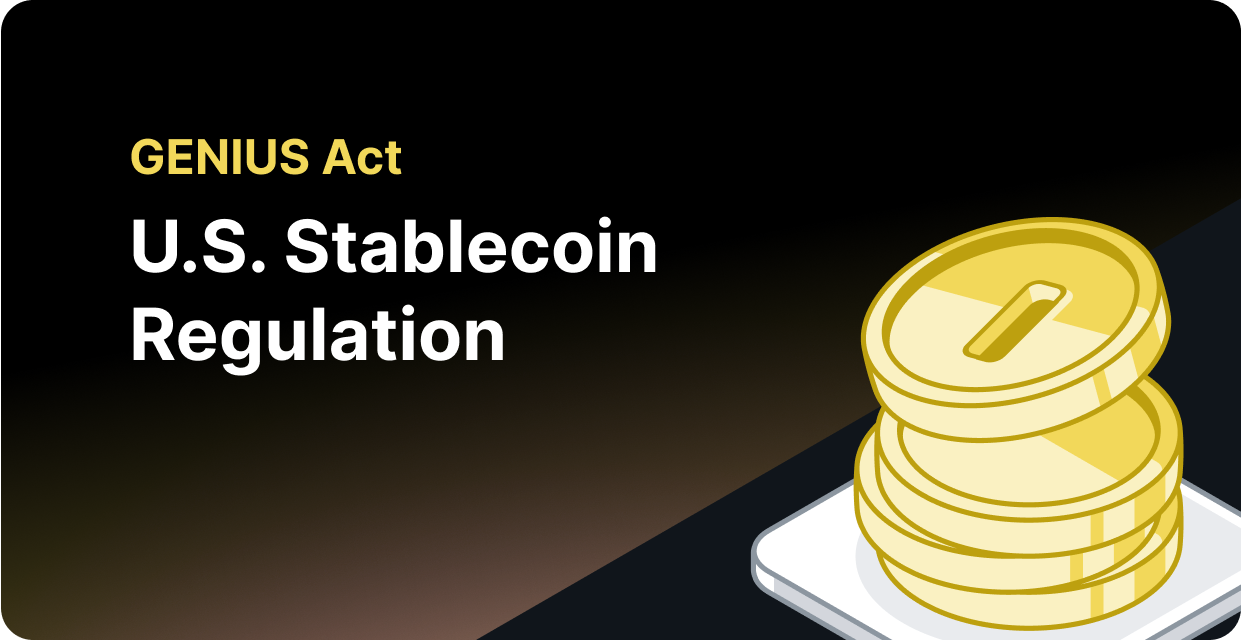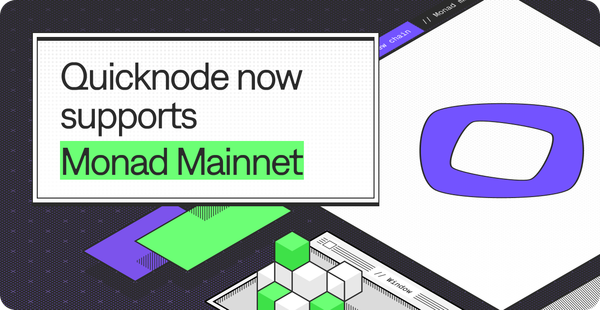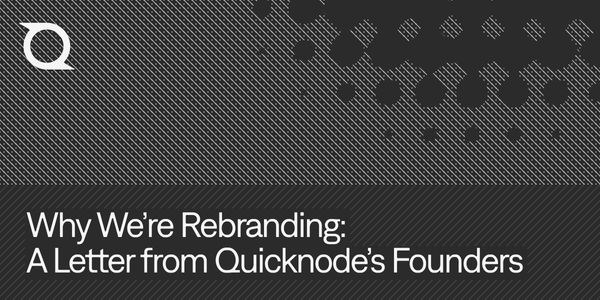The GENIUS Act: How U.S. Stablecoin Regulation Unlocks New Opportunities for Blockchain Infrastructure
See how the GENIUS Act 2025 reshapes U.S. stablecoin rules, driving blockchain growth, institutional use, and USD-backed digital finance.

On July 18, 2025, the U.S. took a defining step toward digital dollar dominance with the signing of the GENIUS Act, a long-anticipated legislative milestone designed to regulate fiat-backed stablecoins. While the crypto industry has debated stablecoin policy for years, the GENIUS Act brings clarity with enforceable standards on asset backing, audits, KYC/AML, and bank-issued tokenized deposits.
But this isn’t just about regulation.
The GENIUS Act signals a massive inflection point for the infrastructure powering stablecoins, from Ethereum L2s to Solana, and from developer tooling to payment rails. With stablecoin market cap at ~$265–269B as of late July/early August 2025 and on pace to approach $300B by year‑end if current trends hold, the demand for reliable, scalable infrastructure is surging.
For years, stablecoin issuers and crypto companies have been building under a cloud of uncertainty, with regulators relying on enforcement actions instead of clear policy. The GENIUS Act changes that.
Let’s unpack what the Act includes, why it matters, and how infra teams like QuickNode are enabling this new wave of compliant growth, grounded in regulatory clarity that lets companies innovate without fear of unexpected and unjustified enforcement.
What the GENIUS Act Actually Says
Signed into law on July 18, 2025, The Government Enactment for Nationally Issued United States Stablecoins (GENIUS) Act represents the most comprehensive federal framework to date for regulating U.S. dollar-backed stablecoins. By setting clear rules for the who, what, where and when, we now have clarity on the issuance, reserves, reporting and supervision.he law removes long-standing ambiguity that has limited institutional adoption. The Act takes effect on the earlier of 18 months after enactment or 120 days after primary regulators issue final implementing rules.
Here are the core provisions:
Permitted Issuers & U.S. Coverage
Only permitted issuers can mint GENIUS-compliant stablecoins. That includes:
- Subsidiaries of insured depository institutions or credit unions, supervised by their federal regulators
- Federally licensed non-bank issuers under the OCC
- State-licensed issuers, provided the state’s regime is deemed “substantially similar” to the federal framework
State issuers can scale up to a cap of $10B in outstanding tokens on a 30-day average. Beyond that, they must transition to federal oversight within 360 days, unless granted a waiver. Regulators also face firm application review deadlines: complete submissions must be approved or denied within 120 days, or they’re automatically approved.
Foreign issuers can only serve U.S. users if they meet comparability and registration standards aligned with U.S. rules and are registered with the OCC.
1:1 Reserve Backing Requirement
All payment stablecoins issued under the GENIUS Act must be backed 1:1 by high-quality liquid assets. This can include:
- Cash deposits
- Short-term U.S. Treasuries
- Federal Reserve bank reserves
This effectively rules out algorithmic or undercollateralized designs for GENIUS-compliant stablecoins. Issuers must maintain full, redeemable reserves that can be verified at any time, aligning more closely with models like USDC and PayPal USD.
Independent Attestations and U.S. Audit Standards
To reinforce trust, the Act introduces both monthly attestations and annual audits:
- Monthly: Issuers must publish public reserve reports with independent third-party attestations verifying composition and supply.
- Annual: Issuers must produce GAAP-based financial statements audited by a U.S.-registered public accounting firm.
Reserves cannot be rehypothecated (except in tightly defined liquidity facilities), and custody must follow federal or approved state safekeeping standards.
AML/KYC Compliance & Custodial Oversight
Every GENIUS-compliant stablecoin issuer must implement robust Anti-Money Laundering (AML) and Know Your Customer (KYC) procedures. This includes:
- Verifying customer identities at issuance and redemption
- Monitoring for suspicious activity
- Partnering with regulated custodians to safeguard reserves
Importantly, this provision aligns with existing compliance requirements for financial institutions, positioning stablecoins as credible tools for cross-border payments, remittances, and B2B settlements.
Tokenized Deposits: A Parallel Track
Tokenized deposits fall outside the GENIUS Act’s payment stablecoin regime. The Act does not newly “legalize” deposit tokens; rather, it preserves banks’ existing authority to tokenize deposits under banking law, while establishing a separate, federal rulebook for payment stablecoins issued by permitted entities. Practically, this creates two regulated tracks that can grow in parallel:
- Banks can issue tokenized deposits as on‑chain representations of customer deposit liabilities under prudential supervision.
- Permitted stablecoin issuers can mint payment stablecoins backed 1:1 by high‑quality liquid assets under the Act’s disclosures, attestations, and BSA/AML controls.
The significance here is that tokenized deposits keep banking services on-chain under prudential oversight, while payment stablecoins open transparent, regulated USD rails for the open blockchain economy.
With both tracks advancing in parallel, the Act ensures that traditional finance and decentralized finance can grow together, reinforcing the dollar’s position as the default settlement layer for global digital finance.
For builders, this separation means distinct compliance and operational requirements per asset type and rising demand for auditable infrastructure that can support both payment stablecoins and deposit tokens across public chains.
Why This Is a Big Deal for Infrastructure
The GENIUS Act isn’t just a green light for stablecoins, it’s a direct signal that infrastructure is now critical financial plumbing. By tying stablecoin issuance to regulatory standards, the Act transforms these assets from experimental tools into regulated financial instruments and that changes the infrastructure game entirely.
Here’s why:
Stablecoins Now Depend on Reliable, Scalable Infra
With new compliance rules come heightened operational requirements. Every stablecoin must now operate with the resilience and observability of a regulated bank, not a side project. That means:
- Real-time transaction indexing for AML/KYC monitoring and regulatory reporting
- Consistent uptime for mint/burn operations, often under heavy load
- Enterprise-grade throughput to support high-volume stablecoin transfers, especially as banks and fintechs begin issuing tokens at scale
A single RPC bottleneck or out-of-sync node isn’t just a tech issue anymore, it’s a compliance failure.
Infrastructure Becomes the Trust Layer
Issuers need more than basic blockchain access. They require auditable infrastructure with controls for:
- Access management (who can sign, mint, or pause contracts)
- Automated key rotation and secure secrets handling
- Historical traceability of every call to their contracts or reserve-related logic
These aren’t optional. In a post-GENIUS world, the infrastructure stack is directly tied to the integrity of a compliant stablecoin program.
QuickNode Is Built for This Moment
QuickNode’s infrastructure is already powering high-performance applications across Ethereum, Solana, Base, and beyond, exactly where stablecoin activity is growing. Our platform supports:
- KYC-compliant activity indexing through custom APIs
- Automated monitoring and alerts to catch anomalies before regulators do
- Global node distribution for latency-sensitive financial applications
Whether you're a fintech issuing tokenized deposits or a protocol integrating regulated stablecoins into payment flows, you can’t afford fragile infrastructure. And that’s where QuickNode comes in.
The Broader Landscape Is Expanding Fast
The GENIUS Act doesn’t operate in isolation. It will catalyze growth across:
- Tokenized bank deposits for real-time settlement
- RWA platforms using stablecoins as payment primitives
- Cross-border payroll and commerce apps relying on USD rails
All of this demands infra that’s secure, scalable, and standards-aligned, not just blockchain-connected, but financial-grade.
As the line between traditional banking and on-chain finance blurs, the infrastructure underneath becomes the single point of leverage. With GENIUS-compliant stablecoins at the center, QuickNode is the execution layer that makes it all real.
The Race for USD Dominance
The GENIUS Act isn’t just about regulating stablecoins, it’s about cementing the U.S. dollar’s role as the backbone of the digital economy.
For years, global regulators have debated how to manage the explosive growth of digital assets. But while others hesitated, the U.S. just made its move. With GENIUS, American lawmakers are effectively turning stablecoins into regulatory-compliant, privately issued digital dollars and when combined with the Anti-CBDC push, they are making a deliberate choice to keep innovation in the hands of the private sector. Unlike China’s state-controlled digital yuan or Europe’s CBDC pilots, the U.S. is signaling that regulated stablecoins, not a federal CBDC, will anchor the next phase of dollar dominance.
This isn’t just regulatory clarity, it’s a geopolitical play.
Stablecoins Are the U.S. Answer to CBDCs
Where other countries lean toward central bank digital currencies (CBDCs), the U.S. is backing regulated, dollar-pegged stablecoins issued by trusted institutions. The benefit? Innovation stays in the hands of the private sector, while the dollar becomes the default unit of account across blockchains.
This direction is further reinforced by the pending Anti-CBDC Act, which would restrict the Federal Reserve from issuing a retail digital dollar. Together with the GENIUS Act, it’s clear the U.S. is doubling down on stablecoins as the private-sector path forward for digital dollars.
This is key: the U.S. doesn’t need a CBDC to stay competitive. It just needs stablecoins to be trusted, usable, and programmable at scale.
A New Era for On-Chain USD Products
For developers, this unlocks the next wave of financial innovation, powered by programmable dollars and supported by a clear compliance framework.
You can now build:
- RWA marketplaces offering tokenized U.S. securities with dollar settlement
- Dollar-denominated DeFi products with safer, audited stablecoin collateral
- On-chain payments for e-commerce and B2B transactions
- Payroll and invoicing tools denominated in USD, settled globally in seconds
These aren’t experiments anymore, they’re products that can go to market today. But with financial-grade demand comes financial-grade responsibility. Every one of these use cases requires:
- Low-latency, high-availability node access
- Reliable indexing for real-time balances and transfers
- Security primitives to ensure funds, data, and user actions are protected
QuickNode Powers the Dollarization of the Blockchain Economy
At QuickNode, we’re not just observers, we’re enabling this shift. Our infrastructure stack supports:
- Global RPC distribution for lightning-fast transaction processing
- Real-time stablecoin analytics via custom APIs and streaming data
- Battle-tested support for top stablecoin issuers and payment apps
As dollar tokens become the dominant liquidity layer across chains, infra providers become the foundation of the digital dollar ecosystem. Every transfer, every mint, every redemption, it all flows through infrastructure.
The GENIUS Act may be a regulatory milestone, but its long-term impact is economic: it opens the door for USD to win not just in trade and settlement, but in smart contracts, DeFi, gaming, and global commerce.
With QuickNode under the hood, builders can now move fast without breaking the rules.
The Institutional Wave Is Coming
Regulatory clarity doesn’t just appease lawyers, it unlocks capital.
Since the GENIUS Act was signed into law, we’ve seen a marked shift in how traditional financial institutions approach blockchain. What was once sandbox experimentation has now turned into full-blown product development.
Across the board, banks, fintechs, and global enterprises are treating stablecoins as the future of programmable dollars.
TradFi Is Entering the Arena
With the risk lowered and compliance paths defined, institutions are finally comfortable building with stablecoins. And they’re moving fast:
- Major U.S. banks are piloting private Ethereum rollups to support low-cost, high-speed USD transfers between internal entities
- Fintech giants are embedding stablecoins like USDC and PYUSD to offer instant withdrawals, top-ups, and settlements for users worldwide
- Large enterprises are beginning to denominate B2B invoices and execute on-chain treasury operations in stablecoins for better liquidity control and auditability
This isn’t some hypothetical roadmap, it’s already happening. The private blockchain era is giving way to public-chain integrations backed by enterprise-grade compliance.
The implication? Stablecoins are no longer just DeFi rails, they’re becoming the core infrastructure of dollar-based digital finance.
Infrastructure Becomes a Strategic Choice
But as institutions enter the ecosystem, their requirements shift dramatically. They’re not looking for hobby-grade setups, they need production-grade infrastructure with guarantees.
They need:
- Strict SLAs with 99.99%+ uptime for mission-critical stablecoin transactions
- Advanced traffic management to handle millions of transactions per day across multiple regions
- Granular observability for compliance reporting, fraud detection, and real-time reconciliation
- Security and isolation features to meet internal IT and risk audits
This is where most platforms fail, but it’s exactly where QuickNode thrives.
QuickNode: Trusted by Builders, Chosen by Institutions
QuickNode has spent years perfecting the infrastructure stack for high-scale blockchain applications. Now, we’re applying that same foundation to support the next wave of institutional stablecoin adoption.
- Global multi-region RPC endpoints ensure low latency for every transaction
- Dedicated infrastructure gives banks and fintechs isolated, secure environments
- Real-time analytics APIs offer deep visibility into stablecoin usage and trends
- Enterprise support tiers offer custom integrations, SLAs, and white-glove onboarding
As stablecoins become the digital dollar standard, institutions need more than access, they need assurance.
With QuickNode, they get a battle-tested, enterprise-grade foundation built for the scale and scrutiny that institutional finance demands.
This isn’t just a trend. It’s a migration.
And it’s already underway.
How the GENIUS Act Sets the Stage for Blockchain Growth
The U.S. has drawn its line in the sand: the future of the dollar is digital, and the rails will be public, programmable, and compliant.
The GENIUS Act doesn’t just give the green light to stablecoins, it transforms them into core infrastructure for global finance. Taken alongside the Anti-CBDC push, the direction is unmistakable: the U.S. is committing to a private-sector-driven stablecoin ecosystem as the foundation of its digital dollar strategy. The rules are clear, the trust layer is forming, and the technical foundation is ready.
What comes next is execution. Developers now have the compliance framework, the liquidity base, and the infrastructure to bring dollar-denominated innovation to every sector, from instant cross-border commerce to institutional DeFi. Stablecoins have moved past the experimental stage; they’re now a competitive advantage for those who can build fast and deploy securely.
In this new era, speed, reliability, and compliance aren’t nice-to-haves, they’re the baseline. And with QuickNode powering the pipelines, the builders who embrace this shift will define how the next generation transacts, settles, and stores value on-chain.
The future of money is programmable. The rails are here. Let’s build on them.
About QuickNode
QuickNode is a leading blockchain infrastructure and solutions provider. Since 2017, we’ve helped thousands of developers and companies scale their onchain applications with lightning-fast, reliable access to over 70 blockchains. Stay ahead in the world of Web3 — subscribe to our newsletter for insights, updates, and the latest innovations shaping the future!





